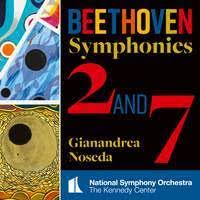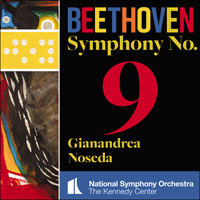BEETHOVEN Symphonies Nos 2, 7 & 9 (Noseda)
View record and artist detailsRecord and Artist Details
Genre:
Orchestral
Label: National Symphony Orchestra
Magazine Review Date: 05/2024
Media Format: Download
Media Runtime: 71
Mastering:
DDD
Catalogue Number: NSO0011D

Tracks:
| Composition | Artist Credit |
|---|---|
| Symphony No. 2 |
Ludwig van Beethoven, Composer
Gianandrea Noseda, Conductor National Symphony Orchestra, Kennedy Center |
| Symphony No. 7 |
Ludwig van Beethoven, Composer
Gianandrea Noseda, Conductor National Symphony Orchestra, Kennedy Center |
Genre:
Orchestral
Label: National Symphony Orchestra
Magazine Review Date: 05/2024
Media Format: Download
Media Runtime: 64
Mastering:
DDD
Catalogue Number: NSO0012D

Tracks:
| Composition | Artist Credit |
|---|---|
| Symphony No. 9, 'Choral' |
Ludwig van Beethoven, Composer
Camilla Tilling, Soprano Gianandrea Noseda, Conductor Issachah Savage, Tenor Kelley O'Connor, Mezzo soprano National Symphony Orchestra, Kennedy Center Ryan McKinny, Bass Washington Chorus |
Author: Andrew Farach-Colton
With these two albums, Gianandrea Noseda and the NSO of Washington DC conclude their Beethoven symphony cycle, and I’m left feeling a bit perplexed by the overall lack of consistency in both the quality of the performances and Noseda’s interpretative perspective. At times, he seems interested in chasing after Beethoven’s metronome markings, for example, or in taking a cue from the period-instrument movement in keeping brass and timpani punchy, and yet he eschews antiphonal seating for the first and second violins throughout. And even from symphony to symphony, his interpretative stance is impossible to pin down.
The Second is the most successful of this last batch – rhythmically alert, muscular and lithe. I love the sense of achievement in the last bars of the opening Allegro con brio, as if the orchestra were taking a well-deserved victory lap, and how the finale opens with a burst of comedic energy. In the latter movement, Noseda’s tempo is especially well judged – quick enough to set the heart racing but with enough breathing room so the strings have time to dig in a bit.
If only his reading of the Seventh was as vividly characterised. I want more change of colour in the Allegretto’s soothing shift to the major, say, and a greater hush in the same movement’s fugal passage, which is merely quiet here, with little sense of mystery. And while the finale is driven hard and very exciting, far too much detail is lost in the blur.
The Ninth is similarly disappointing, despite some lovely details. Note, for instance, the warmth of the dolce passage at 1'59" and how Noseda starts phrasing more generously in the subsequent passage. I was quickly thrown off, however, by the cataclysm at 8'05", which strikes me as sounding strangely joyous here. And in the Scherzo, so many of the dynamic steps and contrasts are glossed over that the result is rather faceless (and for those who care about such things, he takes the Trio section at the traditional tempo rather than as the mad scramble Norrington, Gardiner and others have advocated for).
There’s welcome warmth in the Adagio but also some distractingly unsettled playing – at 4'55", say, and again at 8'03". And although Noseda has an impressively firm grip on the finale, with the various episodes flowing naturally from one to the other (no easy feat), some sections require a more imaginative approach. Take that quasi fugal passage at 10'45" – I like that he infuses it with lyrical energy, but it’s all played at the same level of intensity so that ultimately there’s a feeling of emotional flatness.
The Washington Chorus do a fine job, all things considered, and the solo vocal quartet is well matched. Bass-baritone Ryan McKinny has a pleasingly round tone, even if his pitch isn’t always precisely centred in his opening recitative. And although Issachah Savage has a gorgeously robust tenor voice, he tends to swallow the ends of his phrases in the alla marcia section.
So where does this leave us in terms of the cycle as a whole? Well, curiously, the cycle’s strengths are found largely in the even-numbered symphonies, with the Fourth a particular high point, although the Second, Sixth and Eighth (12/23) are also worth hearing, if only to witness how Noseda and the NSO continue to strengthen their bond.
Explore the world’s largest classical music catalogue on Apple Music Classical.
Included with an Apple Music subscription. Download now.

Gramophone Digital Club
- Digital Edition
- Digital Archive
- Reviews Database
- Full website access
From £8.75 / month
Subscribe
Gramophone Full Club
- Print Edition
- Digital Edition
- Digital Archive
- Reviews Database
- Full website access
From £11.00 / month
Subscribe
If you are a library, university or other organisation that would be interested in an institutional subscription to Gramophone please click here for further information.




